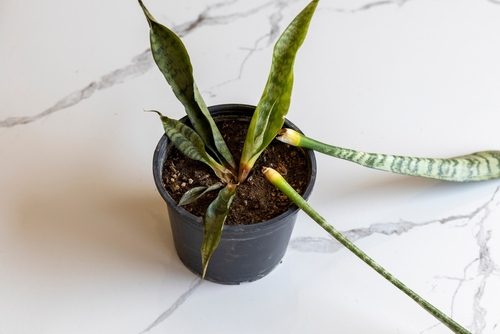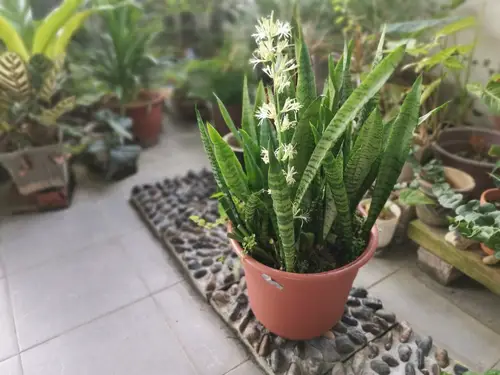Snake plants are a popular houseplant due to their low maintenance and air-purifying qualities. However, sometimes snake plant owners notice Snake plant leaves skinny and wonder what is causing this issue.
Skinny leaves can be a sign of an underlying problem, and it’s important to address the issue to ensure the plant’s health. Understanding snake plants is crucial when trying to identify the cause of skinny leaves.
Snake plants, also known as Sansevieria, are native to Africa and Asia and are known for their long, upright leaves that grow from a central base. They are hardy plants that can tolerate a wide range of conditions, making them a popular choice for indoor gardening. However, even with their resilience, snake plants can still experience issues such as skinny leaves.
Key Takeaways on Why Are My Snake Plant Leaves Skinny
- Skinny leaves on snake plants can be a sign of an underlying problem.
- Understanding snake plants is important when identifying the cause of skinny leaves.
- Causes of skinny leaves include poor lighting, lack of nutrients, and overwatering.
Also don’t miss:
- Why Are My Plant’s Leaves Pointing Up?
- Why Are My Jade Plant Leaves Wrinkled?
- Why Are My ZZ Plant Leaves Curling?
Understanding Snake Plants

Snake plants, also known as Sansevieria, are a popular choice for indoor plants due to their ability to thrive in low-light conditions and their air-purifying properties. They are native to West Africa and belong to the Asparagaceae family.
Snake plants are succulent plants, which means they store water in their leaves and stems, allowing them to survive in dry conditions.
Snake plants have long, upright leaves that grow from a basal rosette. The leaves are usually green with yellow or white stripes, although there are some varieties that have solid green leaves. The leaves can grow up to 4 feet tall, but they are usually much shorter in indoor settings.
One of the unique features of snake plants is that they can grow in a range of temperatures, from 50 to 85 degrees Fahrenheit. They are also quite hardy and can tolerate neglect, making them a great choice for those who don’t have a lot of time to care for their plants.
Snake plants are often confused with Dracaena plants, as they both have long, narrow leaves. However, snake plants have a more rigid, upright growth habit, while Dracaena leaves tend to droop. Additionally, snake plants have thicker leaves that are more succulent in texture, while Dracaena leaves are thinner and more flexible.
Identifying Skinny Leaves in Snake Plants
Snake plants are popular indoor plants that can thrive even in low light conditions and require minimal care. However, they may develop skinny leaves, which can indicate a problem with the plant’s health. Skinny leaves are characterized by a slender and elongated appearance, and they may also appear wrinkled or droopy.
Skinny leaves in snake plants can be caused by various factors, including:
- Underwatering: Snake plants require well-draining soil and moderate watering. If the soil is too dry or if the plant is not getting enough water, the leaves may become skinny and droopy.
- Direct sunlight: While snake plants can tolerate low light conditions, they can get sunburned if exposed to direct sunlight. Too much sun can cause the leaves to become thin and stretched.
- Nutrient deficiency: Snake plants require minimal fertilization, but a lack of nutrients can cause the leaves to become skinny and pale.
- Lack of space: Snake plants can outgrow their pots and become root-bound, which can cause the leaves to become skinny and stunted.
Identifying skinny leaves in snake plants is important to ensure that the plant’s health is not compromised. If the symptoms persist, it is recommended to inspect the plant for pests or diseases that may be causing the problem.
Snake Plant Leaves Skinny – 5 Common Problems
Snake plants are known for their thick, straight, succulent leaves, but sometimes they can become skinny. This can be a cause for concern for plant owners, but there are several reasons why this might happen. In this section, we will explore some of the most common causes of skinny snake plant leaves.
1. Insufficient Light

Snake plants require a moderate amount of light to thrive. If they are not getting enough light, their leaves may become thin and delicate. This can happen if the plant is kept in a location with low light intensity or if it is not exposed to enough direct sunlight.
To fix this issue, move the plant to a location with more light exposure. If the plant is already in a bright spot, consider placing it closer to a window or using artificial light to supplement the natural light.
2. Improper Watering
Overwatering and underwatering can both cause snake plant leaves to become skinny. If the plant is overwatered, the roots may become waterlogged and start to rot, which can lead to a lack of water and nutrients being absorbed by the plant.
On the other hand, if the plant is underwatered, it may not have enough water to support healthy growth.
To fix this issue, ensure that the plant is getting the right amount of water. Water the plant only when the top inch of soil is dry to the touch. Be sure not to let the plant sit in standing water, as this can lead to root rot.
3. Temperature
If the temperature inside your home is too high or too low, it can cause your snake plant to lose its leaves prematurely. Snake plants prefer temperatures between 60 and 85 degrees Fahrenheit. If the temperature drops below 50 degrees Fahrenheit, the plant may suffer damage.
To fix this issue, move the plant to a location with a more moderate temperature. Keep the plant away from drafty windows or doors, and avoid placing it near heating or cooling vents.
4. Nutrient Deficiency
Snake plants require certain nutrients to grow and thrive. If the plant is not getting enough of these nutrients, its leaves may become skinny. This can happen if the plant is not fertilized regularly or if the soil is depleted of nutrients.
To fix this issue, fertilize the plant regularly with a balanced fertilizer. Be sure to follow the instructions on the fertilizer package, as overfertilization can be harmful to the plant.
5. Pests and Diseases
Pests and diseases can also cause snake plant leaves to become skinny. Common pests that can infest snake plants include spider mites and mealybugs. These pests can suck the sap from the leaves, causing them to become thin and delicate. Diseases such as root rot can also cause the leaves to become skinny.
To fix this issue, identify the pest or disease and treat it accordingly. Use a pesticide to control pests, and remove any affected leaves or roots to prevent the spread of disease.
Effects of Skinny Leaves on Snake Plant Growth

When snake plant leaves become skinny, it can indicate that the plant is not receiving enough light or water. This can have a negative impact on the plant’s overall growth and development.
One of the main effects of skinny leaves on snake plant growth is elongation. When a snake plant is not receiving enough light, its leaves may stretch out in an effort to reach more light. This can result in a leggy snake plant with long, thin leaves that are more susceptible to damage.
Elongation can also lead to etiolation, which is a condition where the plant becomes weak and spindly due to lack of light. This can cause the leaves to lose their color and become pale or yellow. Etiolation can also cause the plant to become more susceptible to disease and pests.
In addition to elongation and etiolation, skinny leaves can also affect the development of new leaves. When a snake plant is not receiving enough water or nutrients, it may produce smaller, thinner leaves that are not as healthy as they should be.
This can slow down the plant’s growth and development, making it more difficult for it to reach its full potential.
Caring for a Snake Plant with Skinny Leaves
If you have a snake plant with skinny leaves, it is an indication that something is not right with its care. Here are some tips to help you care for your snake plant and restore it to good health.
1. Adjusting Light Exposure
Snake plants thrive in medium to bright indirect sunlight, but they can also tolerate low light conditions. If your snake plant is getting too much or too little light, it can cause the leaves to become skinny.
Move your snake plant to a south-facing window or a spot with bright, indirect sunlight. If it is in a low-light area, consider rotating it to a brighter spot or supplementing with artificial light.
2. Regulating Watering
Overwatering or underwatering can cause snake plant leaves to become skinny. Water your snake plant only when the soil is dry to the touch. Avoid letting the plant sit in standing water, as this can lead to root rot. If you have been overwatering your snake plant, allow the soil to dry out completely before watering again.
3. Maintaining Temperature

Snake plants prefer temperatures between 60 and 85 degrees Fahrenheit. If the temperature inside your home is too high or too low, it can cause your snake plant to lose leaves prematurely. Keep your snake plant away from drafty areas and maintain a consistent temperature.
4. Addressing Nutrient Deficiency
If your snake plant is not getting enough nutrients, it can cause the leaves to become skinny. Fertilize your snake plant every two to three months during the growing season with a balanced fertilizer. Be careful not to over-fertilize, as this can also damage the plant.
5. Dealing with Pests and Diseases
Pests and diseases can also cause snake plant leaves to become skinny. Check your plant regularly for signs of pests such as spider mites or mealybugs. If you notice any pests, treat your plant with an insecticidal soap or neem oil.
Diseases such as root rot or fungal infections can also cause skinny leaves. If you suspect your plant has a disease, remove any affected leaves and treat the plant with a fungicide.
Preventing Skinny Leaves in Snake Plants
Snake plants are a popular indoor plant selection because they are easy to care for and can thrive in low light conditions. However, they can develop skinny leaves if certain conditions are not met. Here are some tips to prevent skinny leaves in snake plants:
1. Provide Adequate Light
Snake plants need bright, indirect light to grow healthy leaves. If they are not getting enough light, they can become thin and leggy. On the other hand, too much direct sunlight can cause the leaves to burn and turn yellow. Place your snake plant near a bright window that gets plenty of indirect light, but avoid placing it in direct sunlight.
2. Water Properly
Overwatering or underwatering can cause snake plants to develop skinny leaves. Make sure to water your snake plant only when the soil is dry to the touch. When you do water, make sure to water deeply, so that the water reaches the roots. Also, make sure the pot has proper drainage so that excess water can escape.
3. Provide Adequate Space
Snake plants can become root-bound if they are not given enough space to grow. When a plant becomes root-bound, its roots become tangled and can’t absorb nutrients properly, which can cause the leaves to become thin. If your snake plant is root-bound, it’s time to repot it into a larger pot.
4. Prune Regularly

Pruning your snake plant can help it maintain its shape and prevent it from becoming too leggy. You can prune the leaves at the base of the plant or cut off any dead or damaged leaves. Pruning can also help stimulate new growth and keep your plant looking healthy.
5. Acclimate to New Environments
If you are moving your snake plant to a new environment, make sure to acclimate it slowly. Sudden changes in temperature or humidity can cause stress to the plant, which can cause the leaves to become thin. Gradually expose your plant to the new environment over a period of several days to prevent shock.
6. Fertilize Regularly
Snake plants don’t need a lot of fertilizer, but they do need some to maintain their vigor. Use a balanced fertilizer once a month during the growing season to provide your plant with the nutrients it needs to grow healthy leaves.
Frequently Asked Questions
How can I make my snake plant leaves wider?
To encourage wider leaves, ensure your snake plant is receiving enough light. Snake plants do well in bright indirect sunlight or partial shade, but their leaves will become very thin and delicate if they don’t receive enough light.
Additionally, be sure to water your snake plant adequately and avoid over-fertilizing it.
What causes snake plant leaves to become long and skinny?
Snake plant leaves can become long and skinny due to a lack of light, overwatering, or nutrient deficiencies. If your snake plant is not receiving enough light, it may stretch towards the light source, resulting in long, skinny leaves.
Overwatering can cause root rot, which can lead to weak, skinny leaves. Nutrient deficiencies can also cause the leaves to become skinny and weak.
Why does my snake plant look wrinkled?
If your snake plant looks wrinkled, it may be a sign of underwatering or overwatering. If the soil is dry and the leaves are wrinkled, the plant needs more water. However, if the soil is wet and the leaves are wrinkled, the plant is likely overwatered and needs to dry out before being watered again.
What is a fernwood snake plant?
A fernwood snake plant is a type of snake plant with long, narrow leaves that are a deep green color. Unlike other snake plants, fernwood snake plants have a more upright growth habit and are known for their striking appearance.
What does it mean if my snake plant is etiolated?
If your snake plant is etiolated, it means that it has grown tall and leggy due to a lack of light. Etiolation can cause the leaves to become thin and weak, and the plant may eventually topple over. To fix an etiolated snake plant, move it to a brighter location and prune away any leggy growth.
How can I fix a leggy snake plant?
To fix a leggy snake plant, prune away any leggy growth and move the plant to a brighter location. If the plant is severely leggy, you may need to propagate it by taking cuttings and starting new plants. Additionally, be sure to water and fertilize the plant adequately to encourage healthy growth.

Hey, I’m Lisa and I’ve been an avid gardener for over 30 years. I love writing, talking and living in the garden! Feel free to connect with me on my socials below


